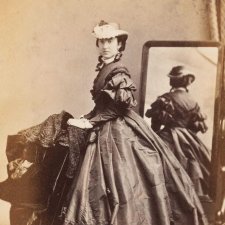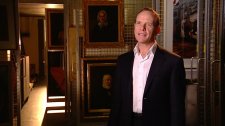- About us
- Support the Gallery
- Venue hire
- Publications
- Research library
- Organisation chart
- Employment
- Contact us
- Make a booking
- Onsite programs
- Online programs
- School visit information
- Learning resources
- Little Darlings
- Professional learning
Sir Henry Barkly GCMG KCB (1815–1898) started his career in business and politics before serving terms as governor of British Guiana and then Jamaica. Appointed governor of Victoria, he arrived in the colony on Christmas Eve 1856, just a few weeks after the first sitting of its newly-created parliament. His term began terribly when his wife and newborn son died as the result of a phaeton accident in April 1857, occasioning much public sympathy. Over the next six years Barkly's priority was securing stable government - a challenge, as into the 1890s the parliament was to comprise generally independent members who clumped and reclumped into factions according to the issues of the day, including land settlement, education, constitutional and electoral reform and payment of parliamentarians. Barkly proved a reliable interpreter of colonial affairs to Britain. Meanwhile, he was a strong supporter of philanthropic and intellectual movements; he was a founder and President of the Royal Society of Victoria, and helped to found the National Gallery, the Acclimatization Society and the National Observatory. In 1863 he became Governor of Mauritius; seven years later he was sent to the Cape of Good Hope. He was recalled to England in 1877, having made several regrettable decisions in Africa. However, after his return he was made a member of the royal commission on Colonial defence. In retirement, as an elected Fellow of the Royal Society and the Royal Geographical Society, he applied himself to science. Barkly is commemorated in the Barkly Tablelands, a huge area of the Northern Territory between Camooweal and Tennant Creek.
The preeminent Melbourne photographic firm Batchelder & O’Neill had its origins in the studio founded on Collins Street in 1854 by the Massachusetts-born photographer Perez Mann Batchelder (1818–1873), who had come to Victoria after several years in California. Batchelder’s brothers Benjamin (1826–1891), Nathaniel (1827–1860) and Freeman (life dates unknown) joined him in Melbourne in February 1856. The firm promised ‘Portraits taken on Glass and Silver Plates by the Collodion and Daguerreotype Process, in the highest perfection of the art’ and ‘in a style surpassed by none in the colonies’. The studio also offered tuition in photography and ‘supplied [the trade] with apparatus and materials of every description.’ Perez Batchelder left Victoria in 1857 and another American, Daniel O’Neill, joined the business. By late 1864, Batchelder & O’Neill – with O’Neill as sole partner – had relocated to Swanston Street. O’Neill later moved to Sydney, where in April 1868 he advertised the availability of his carte de visite of the Duke of Edinburgh’s would-be assassin Henry O’Farrell a week before his execution. Meanwhile, Perez Batchelder had returned to Boston, where he died in 1873. By 1866 the old firm no longer existed, but other photographers traded under the names ‘Batchelder’s Portrait Rooms’ and ‘Batchelder & Co.’ from 1866 to 1895.
Collection: National Portrait Gallery
Purchased 2010



On one level The Companion talks about the most famous and frontline Australians, but on another it tells us about ourselves.



The death of a gentlewoman is shrouded in mystery, a well-liked governor finds love after sorrow, and two upright men become entangled in the historical record.



An interview with former National Portrait Gallery Director, Andrew Sayers, who describes the portrait of Sir Henry Barkly by Thomas Clark.